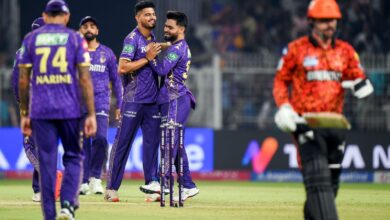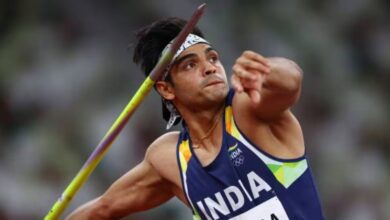From Shlok Ramchandran to Sai Praneeth, Siyadath: The Indian coaching hand in USA’s badminton story | Badminton News

A 31-year-old who won a singles World Championships medal. A 29-year-old who played at the top level in doubles, reaching a career best of world No 32 before retiring at 26. A veteran coach who has been an integral part of India’s recent badminton hory, having a front-row seat at Pullela Gopichand’s famed academy as one of the mentors from the very start.What unites them? From here on, it will be the United States of America.
B Sai Praneeth, who announced his retirement last week, and coach Mohammed Siyadath Ullah will soon be part of USA’s badminton story where Shlok Ramchandran has made a name for himself in recent years, making the move Stateside to explore coaching careers.
USA’s badminton scene
From a well-established badminton structure in India, Sai and Siyadath will be entering a vastly different – yet increasingly vibrant – scene in the USA. For starters, badminton is not even close to being a top sport in the country at any level. Be it the professional leagues, collegiate, or Olympic disciplines. Unlike India, the concept of a national team set-up doesn’t ex, because it is entirely club-driven and largely self-funded. It’s like professional tennis but without the financial returns of that level.
“USA badminton has close to zero funding from the US Olympic Committee, because they work on a dollar-to-medal basis. So there is no funding,” Shlok tells The Indian Express. “So the circuit is entirely driven clubs but there are open tournaments that are sanctioned USAB. A lot of our business revenue is earned through offering our coaching services to various age groups and renting out courts.”
(From left): Sai Praneeth; Mohammed Siyaduttullah with Kidambi Srikanth
The former Indian Thomas Cupper has been mentoring teenagers Allison Lee and Francesca Corbett, who won a horic silver medal at the BWF World Junior Championships 2023, a first for the Pan Am region. According to Ben Lee, Olympian in 1992 and father of Allison, the sport itself has grown a lot just in terms of sheer number of players, but that hasn’t been tracked in the support they have received.
“The sport has changed a lot since my time but unfortunately sponsors and funding has not really progressed,” says Ben – who runs the Synergy Academy where Shlok is employed. “The organization has been struggling for many, many decades and still is actually.”
It is not for the lack of trying, but badminton simply isn’t high on the USOC’s target l. World No 10 Beiwen Zhang, the flagbearer of the sport in the country for so long, took on PV Sindhu recently, Prakash Padukone and Vimal Kumar on her side. But Zhang was herself during coaching breaks, as she was at India Open too, because she still can’t afford to bring her coach to all tournaments she plays around the world.
“Things are improving, better for the next generation, but only very slowly,” Zhang said in Delhi, the emphasis firmly on that last word. “Sports like badminton, ping pong… it’s hard to find sponsors, we don’t have money. What I can do is tell the younger generation what I learned.” She carries the burden of doing well for the country too as Shlok says that US could use a big performance from Zhang at the Olympics and that if she goes on to win a medal, it will open up more funding.
There is also a significant problem in talented youngsters not transitioning. While Allison and Corbett have taken a gap year from their studies to focus on badminton, it’s more common to see players drop out from the sport when they reach college. “In the USA, if you’re not football, basketball, or baseball, you just fall under a second-tier category. These sports offer college scholarships, not badminton,” Ben says.
The Indian presence
But the recent surge of good results could well be attributed to the hiring of high-quality coaching staff across the country, where there is now going to be a significant Indian presence. “Badminton is now able to actually offer coaching careers to people who are interested in coming over from India, Indonesia, and a lot of the Asian and even European countries. If you told me this 30 years ago, that people would be able to make a living coaching in the US I would have told you you’re crazy,” Ben says.
Shlok R (C) with Lee and Corbett to his left, Synergy director Ben Lee (far left)
While Shlok moved to North Carolina first – where Sai is now headed – he has since moved to the Bay Area on the West Coast. Having retired at 26, Shlok dabbled in a few things in India (including briefly working with Chirag Shetty in Goregaon) before the USA coaching offer came. Things might be a bit different now, but back then, Shlok felt Indian coaches wouldn’t be valued as much in the system and took up the Stateside challenge.
His work in North Carolina got noticed Ben, and at Synergy he is now the Coaching Director. Shlok’s experience in a high-performance set-up like India has proved valuable as Allison and Francesca’s rise through the world rankings has proved.
“He brings a great energy to training every day, junior badminton in the US is starting to level up and Shlok has helped, he is an inspiration,” Corbett says. Allison adds: “He has been on the tour, and he has a lot of knowledge about tactics on the court, as well as mindset. He knows everything!”
When Ben met Shlok in North Carolina, they hit it off. “I really liked his vision, approach, drive, passion… Everything about Shlok was what you look for in a good coach. There are certain individuals who can dissect the game. As an effective coach, he can break it down to skill levels and to translate the information to a student.”
While Shlok assed the USA juniors at their horic World Championships campaign last year – where they even beat Denmark – there’s another Indian who has been around longer and is now set to take a significant step up. Abhishek Ahlawat, now Coaching Director at Frisco Badminton in Texas, became the first Indian to be a national Head Coach as he took charge of the USA men’s team at the Pan Am championships.
Ahlawat’s journey is more happenstance. He travelled to the USA in 2014 to play a couple of doubles events, took a holiday for a few months and realised there was a potential career for him there. He found there was a competitive joy in the club structure. “I liked to be connected with the sport as a coach because I had six knee injuries in the past, multiple ACL knee surgeries, I knew that I cannot continue my playing career. Thanks to my mentors in Delhi and my first coach in Rohtak, Vijay Kumar, I had a little bit of a coaching headstart.”
Abhishek Ahlawat (R) on the coaching chair
After starting in California in 2015, he moved to Texas a couple of years later. Ahlawat reckons the big change in helping reputation for Indian coaches in the USA has been India’s success in the sport in the recent past. “Around when I started I was the only one Indian coach at that time in the USA, the odd one out. Then people started to recognize me. A big factor, I would say, was because of Saina, Sindhu, Srikanth, and Sai Praneeth as well, when he got the bronze medal, then HS Prannoy. The major breakthrough was when India beat Indonesia in the Thomas Cup final. And we got our doubles recognition as well,” Ahlawat says.
For Siyadath, who has been ingrained in the Indian set-up for so long, it will be a whole new challenge. “I’ve coached a lot of elite players in India,” Siyadath says about his move to Portland academy in Oregon. “But here I start from scratch and get to put a system in place. All my life I’ve watched Gopi bhaiya change and adapt and not stay with fixed ideas. Now I hope to bring all that I learnt into setting this up for beginners as well as hoping to train some to elite levels.”
Indeed, all of this recent push in hiring overseas coaches is gearing USA towards the Los Angeles 2028 Olympic Games, which Shlok hopes could be a game-changer. “Our goal is to create an Olympian for 2028 from our club’s exing program. People ask me why did you quit so early, everything was so comfortable. I told them it wasn’t good enough for me. So for me creating the next Olympian is not good enough. It’s creating a potential top 10 player who can go on to get a podium finish, that is what I want.”







